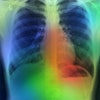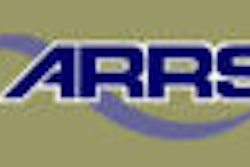Multimodality vendor Philips Medical Systems is giving RSNA attendees a sneak peak at a new CT detector technology that could serve as the platform for a new generation of multislice CT scanners with up to 256 slices and support for CT studies with multiple x-ray energies. The company its touting new clinical applications in MRI and molecular imaging, enhancements in ultrasound, and recent advancements in healthcare IT thanks to its acquisition earlier this year of PACS developer Stentor.
CT
New CT technologies in the Philips booth range from a novel new scanning room concept to work-in-progress developments on new detector instrumentation that will serve as the platform for future Philips multislice CT scanners.
CT Halo is a new room design that applies the Ambient Experience concept, first shown in the company's MRI division, to the CT environment. CT Halo is designed to improve the patient experience by eliminating the architectural barrier between the scanning room and the control room, according to John Steidley, vice president of global marketing for CT.
That barrier exists due to the need to shield scanner operators from radiation. But CT Halo dispenses with walls and instead uses an integrated leaded glass shield and console assembly that hangs from a circular track mounted into imaging suite's ceiling. Ball bearings in the track enable operators to manually move the shield and console into the position they want, while a second shield can be added to allow a patient's loved ones to remain inside the scanning room without being exposed to radiation.
Because it eliminates the need for a separate control room, CT Halo can be installed in a conventional CT imaging suite, and the concept is compatible with the company's complete line of CT scanners, Steidley said. It can also be deployed in an Ambient Experience environment that uses mood lighting and projections to create a more soothing patient experience. CT Halo will be available in the first quarter of 2006, and will cost $95,000 for a single-shield version and $225,000 for a dual-shield version with Ambient Experience.
In cutting-edge research, Philips is demonstrating work under way at its CT center of excellence in Haifa, Israel, on a new detector design based on what it calls nano-panels. The nano-panels are building blocks for detector arrays of any slice width, including 256 slices, Steidley said, and enable the coverage of an entire organ in a single gantry rotation.
Another new detector technology is what Philips calls a Simultaneous Multi Energy detector. The design makes possible the performance of multienergy studies, with different layers of the detector optimized for different x-ray tube energies. For example, the upper layer is designed to stop and detect lower-energy photons, while the bottom layer stops higher-energy photons, with the added advantage that these measurements are made simultaneously.
A scanner using the design is installed at Hadassah Medical Organization in Jerusalem, and the first human images were acquired five days before the RSNA show began, Steidley said. The scans demonstrate the ability of the design to depict the difference between substances that have the same intensity as measured in Hounsfield units, such as calcium and contrast-filled vessels. Philips expects that a product based on the system will be announced in mid-2006.
As a concept, Philips is showing medical atlas-like images of internal anatomy created from CT scans using software developed by a company called Anatomical Travelogue. The reconstructions are too time-intensive for routine clinical use, but could be used as part of patient education efforts, such as demonstrating the impact of lifestyle habits on cardiac anatomy, Steidley said.
On the software side, CT Portal is a thin-client application for image review throughout the healthcare enterprise. It enables image review from a remote site such as a satellite imaging center or a radiologist's home.
Finally, Philips is showing a new table with the capacity to scan patients weighing up to 650 lb, an advantage in bariatric studies. The table is available for the company's large-bore and 64-slice scanners.
MRI
New workflow and clinical applications are being touted in the MRI section of the Philips booth. SmartExam, for example, is designed to improve clinical workflow by automating the time involved in planning MRI studies. SmartExam users can have their lead technologists and subspecialized radiologists create scan protocols for particular applications, such as neurovascular studies, that are then stored and launched with the touch of a button by other scanner operators. Philips believes that SmartExam will save up to 30% of the time spent planning MRI exams, according to Jacques Coumans, vice president of global marketing in the MRI division.
In addition, the company has commercialized its Ambient Experience environment after showing it as just a concept at the two previous RSNA shows. Ambient Experience is designed to reduce patient claustrophobia and subsequent scan retakes by allowing patients to create customized environments such as special lighting and landscape scenes that are projected on the walls of the imaging suite. Ambient Experience is available for owners of the company's high-field magnets, Coumans said.
Philips is also showing new applications based on the company's FreeWave spectrometer for its high-field product line. One such application is k-t Blast, which enables the creation of 3D cine cardiac reconstructions in one breath-hold, and time-resolved keyhole angiography, which produces images rivaling digital subtraction angiography. A third FreeWave application is 2K x 2K image acquisition, which is particularly well-suited for orthopedic studies, Coumans said.
Other recent MRI advances include the commercialization of DWIBS, a diffusion-weighted imaging protocol that produces PET-like images, and FiberTrak, for tracing fibrous tissue detected with multiangle DWI protocols. Philips has also combined spectroscopy with its SENSE parallel imaging technique on its 1.5- and 3-tesla scanners, enabling users to conduct spectroscopy exams with only an additional one to two minute spectroscopy data acquisition.
Molecular imaging
Philips is highlighting its Gemini GXL PET/CT scanner, which began shipping in June 2005. In its RSNA booth, the company is demonstrating a new 3D line of response (LOR) reconstruction algorithm for PET studies. Made possible by recent increases in computer processing power, 3D LOR reconstruction results in a 20% increase in spatial resolution over the company's previous RAMLA-based 3D reconstruction method, according to James Cavanaugh, director of global marketing for nuclear medicine and PET/CT.
Philips is also demonstrating a new PET/CT viewer for its Extended Brilliance Workspace platform. The viewer gives Gemini users access to PET and CT clinical applications, and is designed to enhance workflow and efficiency for clinical users by adapting to their productivity needs.
The application supports real-time slice-to-slice PET/CT displays, a display interface enabling clinicians to optimize their review, and a comparison-view mode for multiple studies from the same patient.
In SPECT, Philips has begun shipping a six-slice version of its Precedence SPECT/CT system. The unit joins a 16-slice model that started shipping in the second quarter of 2005, according to Deepak Malhotra, director of marketing for SPECT/CT. A field upgrade path between the six-slice and 16-slice versions enables customers to start with the less powerful system and upgrade later as their familiarity with SPECT/CT grows, Malhotra said.
Philips also is demonstrating a new Astonish 2.0 reconstruction algorithm based on 3D OSEM (ordered subset expectation maximization) techniques. Appropriate for both planar and SPECT applications, the new algorithm gives gamma cameras PET-like spatial resolution of 4.5 mm.
AutoQuant 6.5 is a new work-in-progress version of the company's cardiac review and quantification software. The upgrade includes a feature simplifying the creation of databases for storing known normal patient exams for comparison with the current exam being studied. The new version also includes new features for users of Philips' Vantage Pro attenuation-correction protocol.
Ultrasound
Philips is highlighting enhancements to several of its ultrasound systems, including its Vision 2005 package for its iU22 scanner. Vision 2005 provides faster volume rates in 4D mode and enhanced image quality, said Ron Leichner, senior director of marketing for general imaging, ultrasound.
The scanner now also features the firm's SonoCT compound imaging technique and advances in transducer technology such as the company's xMatrix array and PureWave crystal technology, according to the firm. In addition, Philips has added a new L9-3 transducer to iU22.
Philips also unveiled HD11 XE, which features a flat-panel monitor with an articulating arm, an adjustable keyboard, cardiac capabilities to streamline workflow, full 4D capabilities, and the ability to work with more than 20 transducers, Leichner said.
In other RSNA introductions, Philips is showcasing HD3, a multipurpose system targeted at the office environment. It offers grayscale and color Doppler imaging, cine loop review, tissue harmonic imaging, an adjustable flat-panel monitor, six scan heads, and analysis packages and measurements for various exams, he said.
IT
The fruits of Philips' acquisition of Stentor are on full display in the firm's booth this year. Philips is highlighting the integration of its iSite PACS network with the Xtenity platform to create a comprehensive healthcare IT package that handles all stages of a patient care cycle.
Philips is pointing to the enhanced communication and interaction features available via Xtenity. Referring physicians can access their patient's health history via Philips' Xtenity Provider Portal, while Xtenity Patient Portal allows patients to actively participate in their healthcare decisions, according to the vendor. Patients can request appointments, check medications, view lab results, and learn more about their medical conditions, Philips said.
As part of the integration, radiologists and radiology technicians can, for example, view the patient's health record at the CT console in the radiology department, according to the firm. In addition, the integration of iSite with Xtenity Enterprise allows for real-time communication of results back to the primary care physician for treatment planning, Philips said.
Also being shown is Version 3.5 of iSite, which adds native MIP/MPR and new clinical tools and enhancements, as well as additional security features, said Mark Reis, senior manager of marketing for the global PACS business unit. iSite 3.5 will be available in mid-December.
Philips also showed its legacy EasyAccess PACS product line. While EasyAccess is no longer being sold in North America, Philips will continue to support its EasyAccess customers and provide them with software upgrades, Reis said.
Philips is also continuing Stentor's policy of offering application programming interface (API) integration with third-party applications. The firm is showing integration with software from firms such as OrthoView and PACSGear, as well as clinical tools developed by the University of Pittsburgh Medical Center.
X-ray
Philips x-ray highlights include the introduction of DigitalDiagnost Compact, a DR system featuring a cesium iodide 17 x 17-inch flat detector mounted on a fixed multipurpose stand.
It includes a tilting and swiveling arm, a trolley with a four-way floating tabletop and a ceiling-suspended tube carrier, said Andrea Winkler, marketing communications manager of general x-ray. DigitalDiagnost Compact is designed to cover general radiography applications at moderate throughput rates.
Philips is also debuting Practix Convenio, a motorized, mobile x-ray system designed primarily for ICU departments. The battery-powered unit, which includes features such as a swiveling arm and fine positioning with a keypad, offers an upgrade path to digital imaging via the firm's PCR Eleva offering, Winkler said.
In other introductions, Philips is showing the next generation of its BV Endura and BV Pulsera mobile C-arm offerings. The systems have received upgrades such as adjustable and foldable flat-panel monitors, a new 1K x 1K imaging chain, automatic contrast and brightness, and auto shutter positioning, she said. Philips has also integrated its ViewForum workstation software into the units.
Philips has also equipped its MultiDiagnost Eleva multipurpose x-ray system with a flat-panel detector. In work-in-progress developments, Philips is displaying the combination of an R&F room with a DR stand.
In cardiovascular imaging, Philips has added a number of features to its Allura Xper FD20 angiography system, including 3D capabilities and the ability to display 2K x 2K images, said Richard Fabian, vice president of marketing for diagnostic imaging: CV x-ray, GXR, CT, MR, ultrasound, and nuclear medicine.
Philips is also featuring XperCT, which allows for soft-tissue imaging capabilities in the interventional suite, and 3D Roadmapping, a new feature that yields a 3D roadmap for fluoro-guided catheter navigation, Fabian said.
By Brian Casey and Erik L. Ridley
AuntMinnie.com staff writers
November 30, 2005
Copyright © 2005 AuntMinnie.com



















